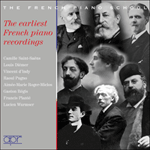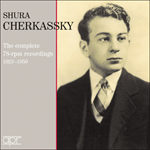
Welcome to Hyperion Records, an independent British classical label devoted to presenting high-quality recordings of music of all styles and from all periods from the twelfth century to the twenty-first.
Hyperion offers both CDs, and downloads in a number of formats. The site is also available in several languages.
Please use the dropdown buttons to set your preferred options, or use the checkbox to accept the defaults.

| Lívia Rév (piano)» More |
The six pieces of Op 19b offer keyboard simulations of three vocal types, the solo Lied (Nos 1 and 2), with a treble cantilena supported by an accompaniment below; duet (No 6), in which the melodic line is doubled in thirds or sixths; and part-song (Nos 3 and 4), featuring homophonic textures in chordal style. Two pieces (Nos 3 and 5) are of sufficient length to unfold in miniature sonata forms. The composer left every piece but the last untitled, though No 3, with its pursuing imitative lines and echoing horn calls, impresses as a Jagdlied (‘hunting song’), and No 4, which shares its key and some thematic material with No 3, as a Jägerlied (‘hunters’ song’). The muted No 6, the Venetianisches Gondellied, was the first of several that Mendelssohn composed and so titled, and was inspired by his visit to Venice in 1830. Its blurry pedal effects and gently undulating cross-rhythms magically conjure up the romantic allure of the Venetian lagoons.
Mendelssohn issued Op 19b and subsequent sets of Lieder ohne Worte in parallel German, French and English editions. In Paris the pieces first appeared as Romances sans paroles, and in England as Original Melodies for the Piano. The composer never used the now prevalent translation Songs without Words, nor did he authorize other descriptive titles fitted to the pieces in later editions, for example ‘Sweet Remembrance’ (No 1), ‘Regrets’ (No 2), and ‘Restlessness’ (No 5). Largely the whims of publishers, these accretions ran counter to Mendelssohn’s own aesthetic, to let the individual Lieder stand by themselves, and to trust the precision of musical expression over the ambiguities of words.
from notes by R Larry Todd © 2013
Les six pièces de l’op. 19b proposent des simulations claviéristiques des trois genres vocaux que sont le Lied pour voix seule (nos 1 et 2), avec une cantilène au soprano étayée d’un accompagnement, en dessous; le duo (nº 6), où la ligne mélodique est doublée en tierces ou en sixtes; et le chant à plusieurs voix (nos 3 et 4), présentant des textures homophones dans un style en accords. Deux pièces (nos 3 et 5) sont assez longues pour se déployer dans des formes sonate miniatures. Seule la dernière pièce a un titre mais, avec ses lignes imitatives qui se poursuivent et ses appels de cor qui se font écho, la troisième a des allures de Jagdlied («chant de chasse») tandis que la quatrième—dans la même tonalité et avec un matériau thématique parfois commun—tient du Jägerlied («chant de chasseurs»). Avec le Venetianisches Gondellied (la pièce nº 6, avec sourdine), Mendelssohn inaugura une série inspirée par son séjour à Venise, en 1830—les effets de pédale flous et les contre-rythmes doucement ondoyants évoquent magiquement le charme romantique des lagons vénitiens.
Comme les autres séries de Lieder ohne Worte, l’op. 19b connut des éditions allemande, française et anglaise; à Paris, on choisit d’abord le titre de Romances sans paroles, et en Angleterre celui de Original Melodies for the Piano. Jamais Mendelssohn n’utilisa la traduction anglaise qui prévaut aujourd’hui, Songs without Words, pas plus qu’il n’autorisa les autres titres descriptifs des éditions ultérieures, comme «Sweet Remembrance» (nº 1), «Regrets» (nº 2) et «Restlessness» (nº 5). Fantaisies d’éditeurs, pour l’essentiel, ces ajouts vont à l’encontre de l’esthétique même de Mendelssohn: laisser les Lieder apparaître d’eux-mêmes et s’en remettre à la précision de l’expression musicale plus qu’aux ambiguïtés des mots.
extrait des notes rédigées par R Larry Todd © 2013
Français: Hypérion
In den sechs Werken von op. 19b werden drei Vokalgenres vom Klavier simuliert, nämlich das Sololied (Nr. 1 und Nr. 2), wobei eine Soprankantilene von den tieferen Stimmen begleitet wird, das Duett (Nr. 6), in dem die Melodielinie durch Terzen und Sexten verdoppelt ist, sowie das mehrstimmige Lied (Nr. 3 und Nr. 4), wo homophone Texturen im Akkordstil vorkommen. Zwei Stücke (Nr. 3 und Nr. 5) sind genügend lang, dass sie sich in Sonatenform en miniature entfalten können. Der Komponist gab nur dem letzten Stück einen Titel, obwohl das dritte mit seinen einander verfolgenden imitativen Linien und widerhallenden Hornsignalen als Jagdlied, und Nr. 4, das in derselben Tonart steht und zum Teil auch dasselbe thematische Material verwendet, als Jägerlied bezeichnet worden ist. Das gedämpfte sechste Stück, Venetianisches Gondellied (inspiriert von seiner Venedigreise im Jahre 1830), war das erste von mehreren Werken Mendelssohns, denen er diesen Titel verlieh. Die verschleierten Pedaleffekte und sich sanft kräuselnden Polyrhythmen beschwören in zauberhafter Weise den romantischen Reiz der venezianischen Lagunen herauf.
Mendelssohn brachte op. 19b und auch folgende Zyklen von Liedern ohne Worte parallel in Deutschland, Frankreich und England heraus. In Paris erschienen die Stücke zunächst als Romances sans paroles und in England als Original Melodies for the Piano. Der Komponist verwendete nie die heute gebräuchliche Übersetzung Songs without Words und deskriptive Titel wie etwa „Sweet Remembrance“ [Süße Erinnerung] (Nr. 1), „Regrets“ [Bedauern] (Nr. 2) und „Restlessness“ [Rastlosigkeit] (Nr. 5), die in späteren Ausgaben hinzugefügt wurden, waren ebenso wenig von ihm autorisiert. Derartige Zusätze ergaben sich zumeist aus den Launen der Verleger heraus und liefen Mendelssohns eigener Ästhetik zuwider, der die Lieder jeweils für sich sprechen lassen wollte und der Präzision des musikalischen Ausdrucks mehr als der Vieldeutigkeit von Worten traute.
aus dem Begleittext von R Larry Todd © 2013
Deutsch: Viola Scheffel
 Mendelssohn: Songs without words Mendelssohn: Songs without words‘An exceptionally discerning musician playing with unaffected sincerity and warmth of affection’ (Gramophone)» More |
 Mendelssohn: Valerie Tryon plays Mendelssohn Mendelssohn: Valerie Tryon plays Mendelssohn BBC Music Magazine» More BBC Music Magazine» More |
 Paderewski - His earliest recordings Paderewski - His earliest recordings |
 The earliest French piano recordings The earliest French piano recordingsThis set brings together some of the earliest and rarest piano recordings ever made, not just in France, but worldwide, and includes the complete solo recordings of all the pianists featured except Wurmser. The French office of the Gramophone Comp ...» More |
 Jorge Bolet - His earliest recordings Jorge Bolet - His earliest recordings‘This invaluable reissue of discs dating from 1952-53 is a reminder of Jorge Bolet's early stature. The first-ever recording of Prokofiev's malignant, ...» More |
 Shura Cherkassky - The complete 78-rpm recordings, 1923-1950 Shura Cherkassky - The complete 78-rpm recordings, 1923-1950In his later years, Shura Cherkassky (1909-1995) was regarded as one of the last ‘Romantics’—a throwback to the so-called ‘golden age’ of pianism in the first decades of the 20th century. As a pupil of Josef Hofmann, he had an impeccable pedigree, ...» More |
 The Piano G & Ts, Vol. 1 - Vladimir de Pachmann, Aleksander Michalowski & Landon Ronald The Piano G & Ts, Vol. 1 - Vladimir de Pachmann, Aleksander Michalowski & Landon Ronald |
 The Piano G & Ts, Vol. 4 - Diémer, Eibenschütz, Hofmann & Backhaus The Piano G & Ts, Vol. 4 - Diémer, Eibenschütz, Hofmann & Backhaus |

